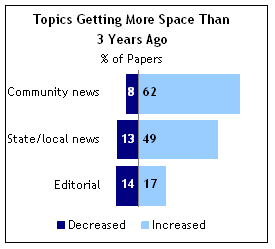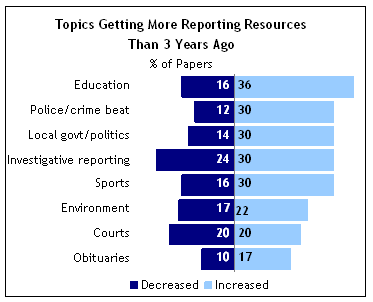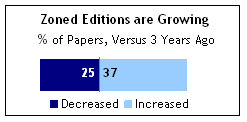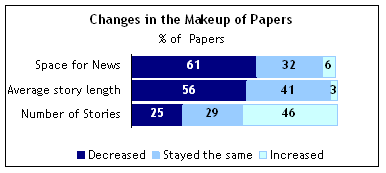What Topics Are Losing Space and Resources
If the papers are smaller in the number of pages and the staffs producing them are shrinking as well, what is being lost and what is being gained? The survey and the in-depth interviews suggest that more is disappearing than is being added.
The survey used three different measures to probe the question. It asked about space devoted to a range of topics. It asked about the amount of reporting resources assigned to cover each topic. And it asked how essential editors thought each topic was to their paper’s identity.

By all three measures, international news is rapidly losing ground at rates greater than any other topic area. Roughly two-thirds (64%) of newsroom executives said the space devoted to foreign news in their newspaper had dropped over the past three years. Nearly half (46%) say they have reduced the resources devoted to covering the topic–also the highest percentage recording a drop. Only 10% said they considered foreign coverage “very essential.”
This decline in foreign news occurs as U.S. armed forces confront stubborn insurgencies in Iraq and Afghanistan, the Administration talks of a global war on terrorism and international trade increasingly impacts the everyday lives of Americans.

This doesn’t mean these larger papers have entirely abandoned original reporting from abroad. For example, the Philadelphia Inquirer (circulation: 334,000) closed the last of its foreign bureaus in November, 2006, yet it still maintains money in its editorial budget for staff foreign travel. Inquirer Editor Bill Marimow said this money is tapped when editors conclude a staff reporter can add significant value to a story.
The fall from favor of national news was similar, albeit slightly less pronounced. Well over half (57%) of newsroom executives said they had reduced the space devoted to national news during the past three years. Four out of ten (41%) said they had cut reporting power devoted to national government/politics and only 18% of editors considered national news “very essential.” This decline came despite one of the most compelling presidential primary races in decades.
Several editors also noted that the national and foreign news that does make it into their papers, is often displayed less prominently. Stories in these categories that were once considered worthy of front page display now frequently appear inside the paper.
“Maybe there was a spot on the front page that everyone considered was the foreign or national story of the day, but that’s changed,” said Sharon Rosenhause, managing editor of the Ft. Lauderdale Sun-Sentinel (circulation: 218,000). “That story is still in the paper, but it’s just inside. To make the front page, it has to be a significant development or a story that we can see through Florida eyes or some kind of Florida prism.”
This decline in national news coverage appears to be part of a larger trend in which America’s dailies have begun reducing routine staff coverage of events outside their immediate circulation area. The editor of a large metro daily said he still sent his paper’s movie critic to cover out-of-town film festivals, but now limited the assignment to only a few days instead of the full event.
“We still have the coverage,” this editor said. “But instead of the full ten days, we’ll go for five.”
Other events that once rated staff coverage are now left to wires.
“There was a time we’d cover big national stories, but we rarely do that anymore,” said this same editor. “In sports, for example, we’ll go to fewer big, out-of-area college basketball, football or auto racing events or games that don’t involve a local team. We take all the major wires, so that’s what we use.”
When editors feel national stories do require staff coverage, many now say they try to find a way to do something entirely unique—to make it part of their distinct franchise. The St. Petersburg Times (circulation 316,000), for example, decided against putting its Washington bureau chief and some members of its political team on the presidential campaign trail, but instead assigned them to an exclusive feature called “PolitiFact,” which effectively runs truth tests on the statements of candidates. The feature, replete with detailed explanations and a “Truth-O-Meter”, rates a comment as true, mostly true, mostly false, false or—if egregiously false—a “pants on fire.”
Space and resources devoted to the coverage of science, business, the arts, and lifestyles have also fallen over the past three years.
Newsroom executives who say they have eliminated jobs that cover specialized beats, such as film or music critics, book reviewers, columnists, national or foreign correspondents, said they had in many cases replaced newsroom-written contributions with syndicated or news agency content—content they get at a fraction of the cost of producing it with staff.
Such tactics have probably stemmed the loss of coverage, but they do carry other costs. Editors say such staff losses reduce their ability to shape coverage to fit the community’s specific interests or needs. For example, offering special treatment to an election in a far-off country that has a large immigrant population locally is no longer in the hands of the paper’s senior editors. Instead, those editors are reliant on agency offerings over which they have far less control. The decline of prestigious newsroom jobs also affects recruitment of new talent, the brightest of which are drawn to newspapers with a broad range of challenging jobs.
At another level, this shrinkage of specialized beats reduces the marketplace of ideas and interpretations as more newspapers decide to cut plum (and thus, expensive) jobs because they can “buy the content elsewhere.” Such a process concentrates the power and the responsibility that goes with reporting these areas into the hands of those organizations that still provide such coverage. One executive editor remarked how, after being forced to lay off the paper’s art critic, the choice of a further staff cut then focused on either the resident film or music critic.
“I hated to make that cut,” the editor said. “I read all these things about how cutting film critics is a good choice because you can get film criticism from other places, but those are the same arguments you hear about foreign coverage, national coverage or state government coverage. Eventually, you wake up one day and find there is no somewhere else because everyone has done the same thing you’ve done. It’s very troubling.”
Science reporting is one such example. Research conducted by Cristine Russell of the Shorenstein Center on the state of science journalism estimates that of the 95 newspapers that published special science sections in the 1980s, only about 35 still do so today. If editor enthusiasm is any measure, a reversal of this trend seems unlikely. Only 10% of editors responding to the PEJ survey said they considered science and technology reporting “very essential” to the quality of their news product.
In making these cuts, editors also don’t necessarily eliminate subject matter altogether. Instead, they tend to dilute it.
Reporters who once concentrated on one beat or specialty now frequently have two or three. Newspapers, for example, that had one reporter assigned to cover local courts might now also assign the same reporter to cover city hall or education after laying off those who covered those beats. In interviews, editors of newspapers that had undergone significant newsroom cuts repeatedly found themselves hard-pressed to name beats that had been abandoned completely. But they agreed the coverage had become thinner and, because of that, its quality had diminished.
Stories are not the only things being downsized to accommodate a smaller newshole. Editors said they are reducing the size of the daily crossword, eliminating stock tables and other tabular material, or scrapping the daily television listings (while keeping the Sunday TV supplement that contains the week’s listings). Yet editors told us these sorts of cuts have frequently been met with intense reader protest, even though the material remains available online. Conversely, more draconian measures, such as cutting foreign news, eliminating or merging features sections, laying off the staff science writer or downsizing the editorial pages have produced comparatively modest reader reaction.
Said Diane McFarlin, publisher of the Herald-Tribune Media Group in Sarasota, Florida (Herald Tribune circulation:114,904), “I’ve gotten no letters from people saying, I don’t think you’re covering as much local news or not doing enough investigative pieces. What I get is hate mail about taking the TV listings, cutting the size of the crossword or moving the comics around. That’s what enrages people.”
But she also cautioned, “The industry may think it’s getting away with eroding local news coverage because it’s an incremental loss and readers don’t react as vociferously and immediately as they do to the loss of daily standards like TV listings and comics.”
What Topics Are Growing

As editors struggle to manage loss, they are also searching for the “franchise” elements of coverage that give people a reason to still read their paper. What is the essential niche? To many editors, the key task is identifying what issues matter most to readers and improving coverage of them—both in print and online—as they trim elsewhere.
The reporting and survey data suggest that this search is leading daily newspapers to focus their diminishing resources closer to home. A whopping 97% of editors rated local news “very essential” to their news product—by far the highest percentage of any news category. Even America’s largest newspapers—those with the greatest reach—gave their highest “very essential” rating (94%) to local news. However, larger and smaller papers diverged sharply on the importance of closer in, even more local, neighborhood, or so-called “hyper-local” news. By nearly a 2-1 margin (83% to 48%), editors from smaller papers placed greater value on neighborhood news than their counterparts from larger papers.

Editors’ responses also indicated that community news is the biggest overall gainer in space. At a time of shrinking newshole, nearly two-thirds (62%) of those responding to the survey said they had increased the amount of space devoted to community and neighborhood news. Among smaller papers, this number was even higher at 67%.
In each of seven specific topic areas where editors said they had added reporting power over the past three years there was a strong local news component: local government and politics, education, the environment, police, sports, obituary writing and investigative reporting. Education was the biggest gainer, with 36% of newsroom executives saying that had added reporting power in this area Lisa Walker, executive director of the Education Writers Association in Washington, DC, described today’s daily newspaper education beats as increasingly “very local”, with less emphasis on broader context and less coverage of national trends than was once the case.

Staffing for coverage of sports, local government and politics, police and investigative reporting, all grew in 30% of the newsrooms surveyed. Although not specifically measured in the survey, anecdotal evidence suggests that at least some of these gains have been driven by pressure to provide web content during the course of the day. Some of this content is often then “reversed published” back into the newspaper.
The focus on local news is also driving changes in zoned editions, those sections of the papers focused on specific communities or areas. Editions catering to the outer fringes of a paper’s circulation area are being closed as new ones are launched with content targeted for communities and neighborhoods within the core circulation area. Nearly four in ten editors surveyed (37%) said they had increased the number of zoned or targeted neighborhood editions they produce, while 25% had reduced them. And the push toward local sections is even higher for smaller circulation papers (44% are increasing, versus 20% reducing them).

Investigative Teams—and Their Stories—Survive
One area that most editors insist they will not cut back on is investigative or watchdog work. Those who manage papers both small and large seem to believe this is an essential part of a paper’s role, and one that fits with whatever their future business model will be.
In face-to-face interviews, editors from both larger and smaller papers invariably stressed their belief that strong investigative, explanatory, reporting remained at the core of daily newspaper journalism. This collective opinion was reinforced by the survey results, where 91% of all newsroom executives said they considered investigative or enterprise reporting either “very essential” or “somewhat essential” to the quality of their news product.
The survey data, however, suggest that larger papers are more committed to the watchdog role than smaller papers. Despite financial pressures and newsroom cuts elsewhere, half the editors from these papers said they had increased their investigative reporting staff over the past three year—twice the figure for smaller papers (24%). Over 90% of newsroom executives from larger papers considered investigative reporting “very essential” compared to just over half (52%) of their counterparts from smaller papers.
In interviews, several newsroom managers declared that their investigative reporting teams would be the last hit by newsroom downsizing. To be sure, they admitted that financial pressures today force them to be more selective in their choice of such labor-intensive editorial projects. They also noted investigative stories tend to run shorter than they did a few years ago and cost more to produce because of additional editing time required to package them for both print and web presentation. But there was evidence that advances in information technology, such as the ability to mine new electronic data bases, has enriched this genre and opened new doors for newspapers to explore important issues.
One editor of a large metropolitan daily contended this move toward smaller and stronger larger stories mirrored the trend of technology itself, where consumers are happy to watch a film on a two-inch iPhone or a 70-inch mega-screen, but find the 26-inch screen passé.
Together, these two developments—shorter news stories and richer enterprise—reflect part of a new, evolving role of the print newspaper in an era of growing online access to news virtually as it happens. In this environment, the role of the print edition of daily newspapers is becoming less a vehicle to convey news developments and more a source for analysis, texture and context to help readers better understand those developments.
Led by papers such as the New York Times (circulation: 1.1 million), editors in recent years have tended to place more analysis or enterprise stories tied to the news on the front page, while often placing the news story itself inside. The Virginian Pilot in Norfolk, Virginia (circulation: 175,000) is a leader in page one experimentation. It has repeatedly published dramatic front pages that are closely tied to the day’s news, yet contain no story in conventional format. On Memorial Day this year, for example, the Pilot devoted its entire front page to an illustration of a local Vietnam War hero’s gravestone, his Medal of Honor citation, and a single paragraph of text noting the holiday that concluded with the exhortation: “Honor them.”
Story Length
Editors indicated they also had become more selective, not just in what stories to cover and how to cover them, but also on story length. A story marking an incremental development—say, on a running city hall squabble that might have warranted a 12 to 15-inch third-day story a few years ago—is part of a dying breed. Today, such developments are either judged unworthy of coverage at all or are covered by a beat reporter in a quick-hit couple of paragraphs that are posted on the website. Depending on the weight of news day, the story either dies there, or can be “reverse published” into the newspaper as a 6-inch short or a brief.
Secondary national or international developments given modest stand-alone treatment a few years ago, have suffered a similar fate. As a result, the quantity of briefs appearing in today’s daily newspapers has risen, but so too has the quality. They have become more than fillers.
“Cut the 15-inch story to 6 for the paper, let the reporter put the other nine in his (on-line) blog for a reader who wants more information and everybody wins,” summed up Mark Zieman, editor of the Kansas City Star (circulation: 252,000) for over a decade before being named the paper’s president and publisher last March.
St. Petersburg Times Executive Editor and Vice President Neil Brown said he believed shorter story length is also the result of more disciplined editing. “We’re more rigorous in our editing now,” he said. “We recognize that some of those stories may have been marginal, or even filler. So the 25-inch story is down to 10, 12, or 6 inches.”
The Washington Post’s (circulation: 673,000) presidential election campaign coverage is an example of this trend. Summaries of campaign highlights are collected into a series of briefs and run under a distinct logo dubbed “The Trail.” The Trail also appears as a blog on the paper’s website, washingonpost.com. Related developments or themes that touched several primary campaigns were collected together and written into a single roundup rather than as a series of disconnected stories. Post executive editor Leonard Downie, Jr., said that during the campaign four years ago, most of what today is covered as briefs or in single roundups would have run as separate, medium-length stories. He described the 2008 election coverage format as a prototype for presenting other news elsewhere in the paper.

Such approaches help explain why, at a time of shrinking newshole and newsroom staffs, a large majority (75%) of editors said their story counts—the number of stories appearing in the paper—had either increased or remained the same during the past three years. As a result, today’s readers receive a similar, or even greater, breadth of coverage in their daily paper than a few years ago, however much of it comes in more of a digest form.
Editors differed in their views of what has been lost in this condensation of stories. For some, it is important background, context, additional sourcing and interesting ancillary points that have gone—losses that significantly devalue the shorter story. Others, however, dismissed the lost material as, more often than not, either arcane detail written into the story by a reporter trying to impress his sources or padding to give the story the appearance of greater importance than it actually was. Either way, the content lost in the print version of the story doesn’t always disappear completely. Instead, much of it migrates to the web as beat reporters write these minor twists and turns of a running story either into their own blog or as short, stand-alone website stories.
In interviews, editors generally seemed accepting of the trade-off. “It’s part of what’s enabled us to have new forms of political coverage that convey more information than we’ve ever had before,” Downie said. “Stories are definitely shorter—unless they need to be longer, such as profiles.”




